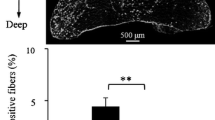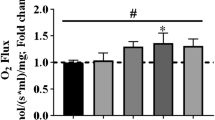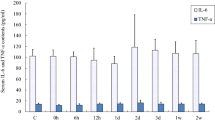Summary
Strenuous physical exercise induces necrosis of skeletal muscle fibers and increases lysosomal enzyme activities in surviving muscle fibers. This study examines the ultrastructural basis of the stimulation of the lysosomal system in mouse vastus medialis muscle during the appearance and repair of exercise-induced (9 h of running) injuries. Necrotic fibers appeared the day after exercise and an inflammatory response with the replacement of necrotic fibers by phagocytes was highest 2–3 days after exertion. Ultrastructural study of surviving muscle fibers revealed numerous autophagic vacuoles, residual bodies, and spheromembranous structures at the periphery of myofibers, especially in fibers adjacent to necrotic fibers. The autophagic response was most prominent between 2 and 7 days after exertion. Autophagic vacuoles with double or single limiting membranes contained mitochondria at various stages of degradation. Vacuolar and multilamellar structures were also observed in regenerating muscle fibers. The structure of injured skeletal muscle fibers returned to normal within 2 weeks. It is proposed that increased autophagic activity could be related to the breakdown of cellular constituents of surviving muscle fibers to provide structural elements for regenerating muscle fibers.
Similar content being viewed by others

References
Christie KN, Stoward PJ (1977) A cytochemical study of acid phosphatase in dystrophic hamster muscle. J Ultrastruct Res 58:219–234
Clarke JTR, Karpati G, Carpenter S, Wolf LS (1972) The effect of vincristine on skeletal muscle in the rat. A correlative histochemical, ultrastructural and chemical study. J Neuropathol Exp Neurol 31:247–266
Decker RS, Poole AR, Crie JS, Dingle JT, Wildenthal K (1980) Lysosomal alterations in hypoxic and reoxygenated hearts. II. Immunohistochemical and biochemical changes in cathepsin D. Am J Pathol 98:445–456
Decker RS, Wildenthal K (1980) Lysosomal alterations in hypoxic and reoxygenated hearts. I. Ultrastructural and cytochemical changes. Am J Pathol 98:425–444
Ericsson JLE (1973) Mechanism of cellular autophagy. In: Dingle JT, Fell HB (eds) Lysosomes in biology and pathology, vol 2. North-Holland, Amsterdam, pp 345–394
Friden J, Sjöström M, Ekblorn B (1981) A Morphological study of delayed muscle soreness. Experientia 37:506–507
Gale (1981) The use of electron microscopy in the investigation of exercise-related muscle failure. In: Nagle FJ, Montoye HJ (eds) Exercise in health and disease. Charles C Thomas, Springfield, pp 79–112
Getzen LC, Carr III JE (1967) Etiology of anterior tibial compartment syndrome. Surg Gynecol Obstet 125:347–350
Gollnick PD, Ianuzzo CD, King DW (1971) Ultrastructural and enzyme changes in muscle with exercise. In: Pernow B, Saltin B (eds) Muscle metabolism during exercise. Plenum Press, New York, pp 69–85
Hecht A, Schumann H-J, Kunde D (1975) Histologische und enzymhistochemische Befunde am Skelettmuskel der untrainierten Ratte nach intensiver physischer Belastung. Med Sport [Berl] 15:270–274
Helminen HJ (1975) The cellular mechanisms of hormonally induced tissue atrophy. In: Trump BF, Arstila AU (eds) Pathology of cell membranes, vol 1. Academic Press, New York, pp 293–322
Highman B, Altland PD (1963) Effects of exercise and training on serum enzyme and tissue changes in rats. Am J Physiol 205:162–166
Hirsimäki P, Trump BF, Arstila AU (1976) Studies on vinblastine-induced autophagocytosis in the mouse liver. I. The relation of lysosomal changes to general injurious effects. Virchows Arch [Cell Pathol] 22:89–109
Kerr JFR (1973) Some lysosome functions in liver cells reacting to sublethal injury. In: Dingle JT (ed) Lysosomes in biology and pathology, vol 3. North-Holland, Amsterdam, pp 365–394
Lin CT, Chen LH (1982) Ultrastructural and lysosomal enzyme studies of skeletal muscle and myocardium in rats with longterm vitamin E deficiency. Pathology 14:375–382
MacDonald RD, Engel AG (1970) Experimental chloroquine myopathy. J Neuropathol Exp Neurol 29:479–499
McDowell EM, Trump BF (1976) Histologic fixatives suitable for diagnostic light and electron microscopy. Arch Pathol Lab Med 100:405–414
Meijer AEFH, Israel DE (1979) The increase in activity of acid hydrolases in muscles of rats after subcutaneous administration of dimethyl-para-phenylene diamine. A combined histochemical and biochemical investigation 1. The histochemical investigation. Histochemistry 61:81–91
Pfeifer U (1978) Inhibition by insulin of the formation of autophagic vacuoles in rat liver. A morphometric approach to the kinetics of intracellular degradation by autophagy. J Cell Biol 78:152–167
Pfeifer U (1982) Kinetic and subcellular aspects of hypertrophy and atrophy. Int Rev Exp Pathol 23:1–45
Reneman RS (1968) The anterior and the lateral compartment syndrome of the leg. Mouton & Co, Hague
Reznik M (1973) Current concepts of skeletal muscle regeneration. In: Pearson CM, Mostofi FK (eds) The striated muscle. Williams and Wilkins, Baltimore, pp 185–225
Salminen A, Vihko V (1980) Acid proteolytic capacity in mouse cardiac and skeletal muscles after prolonged submaximal exercise. Pflügers Arch 389:17–20
Salminen A, Vihko V (1982) Changes of dipeptidyl aminopeptidase activities in mouse skeletal muscle following prolonged running. Comp Biochem Physiol 71 B:23–27
Schiaffino S, Hanzlikova V (1972) Studies on the effect of denervation in developing muscle II. The lysosomal system. J Ultrastruct Res 39:1–14
Schmalbruch H (1980) The early changes in experimental myopathy induced by chloroquine and chlorphentermine. J Neuropathol Exp Neurol 39:65–81
Schumann H-J (1972) Überlastungsnekrosen der Skelettmuskulatur nach experimentellem Laufzwang. Zentralbl Allg Pathol 116:181–190
Shannon AD, Adams EP, Courtice FC (1974) The lysosomal enzymes acid phosphatase and ß-glucuronidase in muscle following a period of ischaemia. Austr J Exp Biol Med Sci 52: 157–171
Simonson E (1971) Physiology of work capacity and fatique. Charles C Thormas, Illinois
Sjöström M, Ängquist K-A, Rais O (1980) Intermittent claudication and muscle fiber fine structure: correlation between clinical and morphological data. Ultrastruct Pathol 1: 309–326
Sjöström M, Neglen P, Friden J, Eklöf B (1982) Human skeletal muscle metabolism and morphology after temporary incomplete ischaemia. Eur J Clin Invest 12:69–79
Vihko V, Rantamäki J, Salminen A (1978a) Exhaustive physical exercise and acid hydrolase activity in mouse skeletal muscle. Histochemistry 57:237–249
Vihko V, Salminen A, Rantamäki J (1978b) Acid hydrolase activity in red and white skeletal muscle of mice during a two-week period following exhausting exercise. Pflügers Arch 378:99–106
Author information
Authors and Affiliations
Rights and permissions
About this article
Cite this article
Salminen, A., Vihko, V. Autophagic response to strenuous exercise in mouse skeletal muscle fibers. Virchows Archiv B Cell Pathol 45, 97–106 (1984). https://doi.org/10.1007/BF02889856
Received:
Accepted:
Issue Date:
DOI: https://doi.org/10.1007/BF02889856



